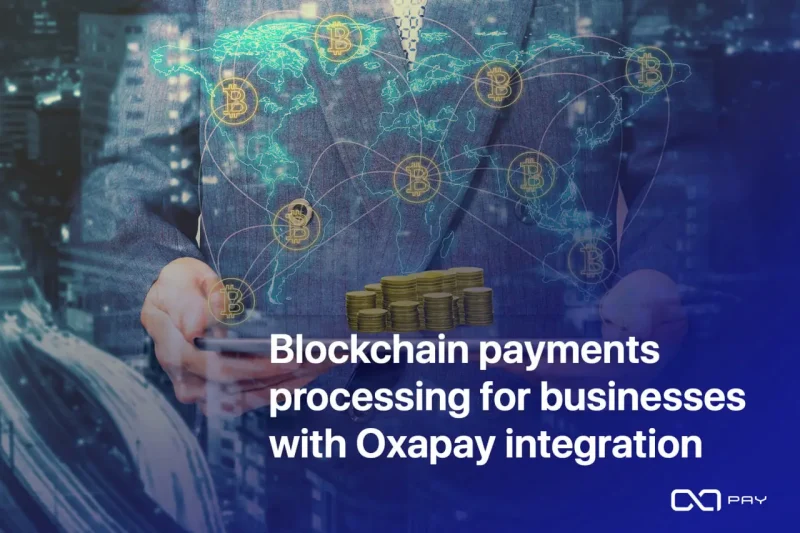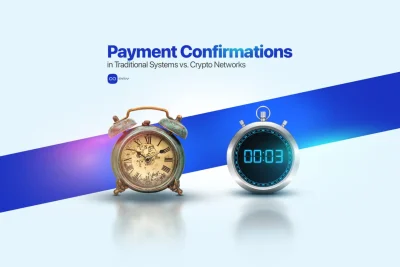Smooth and secure payment processing is crucial for any successful business. However, traditional systems often face delays, high costs, and security risks. Blockchain technology offers a promising alternative, providing faster, safer, and more affordable transactions. This article examines how blockchain could change business payments. We discuss the flaws in old systems, reveal blockchain’s strengths, and highlight its benefits for businesses. We also introduce OxaPay, which makes integrating blockchain payments easy.
What is Payment Processing ?
Payment processing is how businesses get paid by customers. It includes checking, completing, and managing money transactions. Effective payment processing is crucial because it impacts a business’s cash flow, customer happiness, and overall efficiency.
A Look at Traditional Payment Systems
Traditional payment systems involve many parties, like banks, credit card companies, and payment processors. These systems often face delays, charge high fees, and are vulnerable to fraud. They rely on intermediaries to check, handle, and complete transactions, which adds complexity and cost.
Introducing Blockchain: A New Era for Secure Transactions
As businesses struggle with the limits of traditional payment systems, blockchain offers a new solution. It brings a more secure and efficient way to handle financial transactions. Moreover, blockchain technology is changing how we process payments by solving many old problems and removing unnecessary steps and parties.
What is Blockchain?
Blockchain is a technology that records all transactions on multiple computers at once. It keeps each transaction in a “block” and lines them up one after the other, forming a “chain.” Once a block joins the chain, no one can change it. This method ensures there is no single weak point, keeping the data safe and accurate. Additionally, all the computers in the network check and confirm every transaction, making the process very secure and transparent.
How Does Blockchain Work?
Blockchain uses a system that spreads data storage across many locations to avoid using middlemen like banks, which can help reduce costs and speed up transactions. Transactions are put into blocks and arranged in order. Everyone in the network agrees on these transactions through a special process before they are added, ensuring everything is correct and secure. This helps keep the entire process open and trustworthy.
Key Features of Blockchain
- Decentralization: Blockchain spreads its work across many computers instead of one central place. This means no single person or group controls everything, which lowers the chance of unfair control or data tampering. Even if part of the system goes down, the rest can keep running smoothly.
- Transparency: Blockchain records all transactions openly, so anyone in the network can check and confirm them. This openness builds trust. Moreover, it allows everyone to review every action, making it hard for anyone to cheat or commit fraud.
- Security: Blockchain uses complex math to protect data, ensuring that once you record something, you cannot change or erase it. This security measure helps prevent fraud. Additionally, when you add a transaction, many users must agree on it, adding another layer of security.
How Blockchain Payments Work
In blockchain payments, a network of connected systems verifies each transaction. Every new transaction gets added to a previous “block” of data, creating a secure and unchangeable chain. This process uses cryptographic security and group agreement, making sure every transaction is clear and protected. This method makes payments fast, reliable, and safe.
Benefits of Blockchain for Business Payments
Blockchain offers several advantages for business payments, organized into key areas that showcase its transformative impact:
A. Increased Security and Reduced Fraud
- Enhanced Security:Blockchain is strong because it uses decentralization and cryptography. It encrypts each transaction and links it to the previous one, making it very secure and hard to change without permission. This cryptographic chaining means that once you record data, you cannot change it without changing all the following blocks. This process is extremely difficult and unlikely.
- Eliminating the Risk of Single Points of Failure: Traditional payment systems often rely on a central authority (like a bank or payment gateway), which can become a single point of failure. If this central system is compromised, the entire network can be at risk. Blockchain’s decentralized nature means that there is no central point of control or failure, which significantly enhances the resilience and reliability of the payment system.
B. Faster and More Efficient Transactions
- Streamlining Cross-Border Payments: Blockchain allows transactions to bypass traditional financial intermediaries and regulatory frameworks that can delay processing. This capability is particularly valuable for international transactions, where blockchain reduces the time from days to mere minutes or seconds.
- Real-Time Settlement and Reduced Processing Times: Unlike conventional banking systems, where settlements can take several days, blockchain enables real-time or near-real-time transaction settlements. This speed is due to the continuous operation of blockchain networks that do not rely on traditional banking hours or interbank transfer systems.
C. Lower Transaction Costs
- Cutting Out Intermediaries and Reducing Fees: Blockchain transactions do not necessarily require intermediaries like banks or payment processors, who typically add transaction fees. By enabling peer-to-peer transactions, blockchain can significantly reduce or even eliminate these costs.
- Streamlining Back-Office Operations: Blockchain can automate various back-office functions such as reconciliation and audit trails. Smart contracts, or self-executing contracts with the terms of the agreement directly written into code, automate these processes that are traditionally labor-intensive and costly.
D. Improved Transparency and Trust
- Immutable Records for Enhanced Accountability: The immutability of blockchain ensures that once a transaction is recorded, it cannot be altered. This feature is crucial for accountability and auditability, as it provides a verifiable and permanent record of all transactions.
- Empowering Businesses and Customers: Transparency is one of blockchain’s key features, as all transaction records are accessible to all network participants (while maintaining privacy and security of sensitive information). This visibility helps build trust as all parties can verify transactions independently, leading to more secure and confident business relationships.
Challenges and Solutions of Accepting Payments in Blockchain
Using blockchain for payments comes with its own set of challenges, such as complex technology, scalability issues, and unclear regulations. To address these, improving user interfaces can make the technology easier to use. Enhancing the ability of networks to handle more transactions can address scalability. Working closely with regulators can help clear up legal uncertainties. These steps aim to make blockchain easier to use and more compliant with laws, meeting the needs of businesses and consumers better.
The Future of Blockchain in Payment Processing
The future of blockchain in payment processing looks promising as the technology develops. For instance, innovations that let blockchain handle more transactions and work with existing financial systems could lead to wider use. Consequently, these advancements could make blockchain a key part of modern payment systems, ultimately changing how we handle money digitally.
Integration of Blockchain for Payment Processing with OxaPay
OxaPay is a crypto payment gateway that helps businesses easily accept cryptocurrency transactions. By using OxaPay, companies can enjoy lower transaction fees, better protection against fraud, and quicker settlements than traditional payment methods offer. This integration improves the efficiency and accessibility of transactions, connecting businesses to the expanding market of cryptocurrency users with a secure and modern payment solution.
Getting Started with OxaPay
To begin using OxaPay, businesses simply need to sign up at the OxaPay payment gateway, connect its API to their existing systems, and set up their preferences for accepting cryptocurrencies. OxaPay supports users through the entire setup to ensure a smooth start.
Conclusion
Blockchain technology offers a powerful option for businesses looking to improve the security, transparency, and efficiency of their payment processes. With the OxaPay blockchain payment gateway, incorporating blockchain into your business operations is simpler than ever. Start now to move towards a more efficient and secure future for your business payments.




